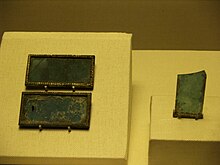
Ancient Chinese glass refers to all types of glass manufactured in China prior to the Qing dynasty (1644–1911). In Chinese history, glass played a peripheral role in arts and crafts, when compared to ceramics and metal work.[1] The limited archaeological distribution and use of glass objects are evidence of the rarity of the material. Literary sources date the first manufacture of glass to the 5th century AD.[2] However, the earliest archaeological evidence for glass manufacture in China comes from the Warring States period (475 BC to 221 BC).
The Chinese learned to manufacture glass comparatively later than the Mesopotamians, Egyptians and Indians.[3] Imported glass objects first reached China during the late Spring and Autumn period – early Warring States period (early 5th century BC), in the form of polychrome 'eye beads'.[4] These imports created the impetus for the production of indigenous glass beads.
During the Han period (206 BC to 220 AD) the use of glass diversified. The introduction of glass casting in this period encouraged the production of moulded objects, such as bi disks and other ritual objects.[5] The Chinese glass objects from the Warring States period and Han dynasty vary greatly in chemical composition from the imported glass objects. The glasses from this period contain high levels of barium oxide (BaO) and lead, distinguishing them from the soda-lime-silica glasses of Western Asia and Mesopotamia.[6] At the end of the Han dynasty (AD 220), the lead-barium glass tradition declined, with glass production only resuming during the 4th and 5th centuries AD.[7]